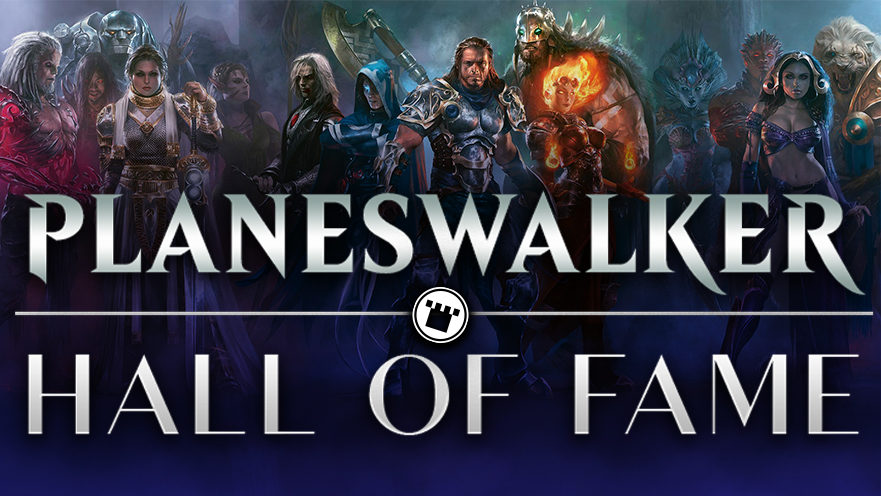When Autumn Burchett won the first Mythic Championship, they did so with a lone copy of Jace, Cunning Castaway in their sideboard. With that victory, Stupid Sexy Jace became a championship-winning planeswalker, something that many would have found surprising back when Ixalan was first released. As I looked over the decklists, though, a thought occurred to me:
Which planeswalker cards have been the winningest over the history of the Pro Tour, World Championships, and Mythic Championships?
Ranking the Planeswalkers
To narrow down my data, I took a cue from the Pro Tour Hall of Fame voting process. When evaluating inductees into the Hall of Fame, many voters weigh Top 8 finishes and wins as the key metrics for determining skill and longevity. With that as my focus, I dove into every Pro Tour and World Championship Top 8 decklist between the current era and 2007, when planeswalkers were introduced. I recorded every copy of a planeswalker card that was featured in those lists, and created a simple scoring system:
- Main deck copy = 3 points
- Sideboard copy = 2 points
- Championship main deck copy = 6 points
- Championship sideboard copy = 4 points
With my system established, I plugged all the numbers in and generated a rank-ordered list of the most successful planeswalkers on the game’s most prestigious stage. Some results were predictable, while others were truly surprising.
Before we explore the Top 10, however, I first want to share a few bits of trivia:
- Of the 92 individual planewalker cards eligible for a Pro Tour (excluding Planeswalker Deck cards), 62 have been featured in at least one Top 8.
- The original Chandra Nalaar is the only planeswalker to make a Top 8 solely based on Limited performance.
- No card currently in Standard made the Top 10, but Teferi, Hero of Dominaria is within striking distance, in 14th place.
- Only a single point divided the #10 and #11 cards on the list. Ajani Vengeant is our honorable mention, clocking in at the 11th place spot with 83 points.
However, Ajani was pushed out of the Top 10 by…
#10: Elspeth, Knight-Errant
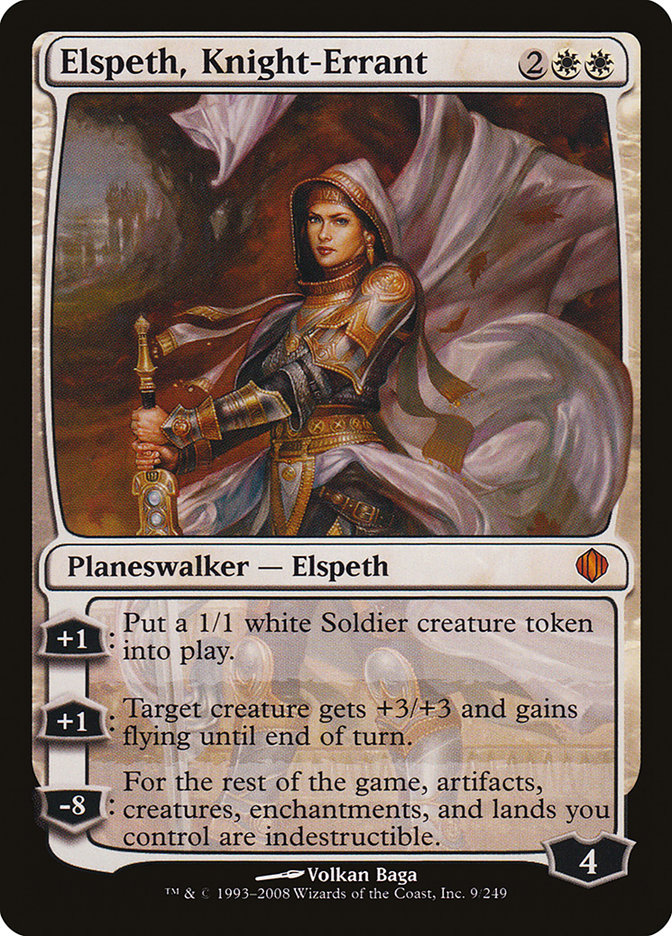
Points: 84
Copies: 17 maindeck, 15 sideboard
Championships: 1 (PT Austin 2009)
In the early days of the planeswalker era, Elspeth was head-and-shoulders above the competition of her time. She was the first planeswalker to have two abilities that added rather than subtracted loyalty, giving her versatility and survivability at once. Her ranks of 1/1 Soldier tokens played fantastic defense, and they could even snowball into a win condition. Her most high-profile victory came at the hands of Brian Kibler, whose lone copy of Elspeth set the tone in the Zoo mirror match of the Pro Tour Austin finals.
#9: Xenagos, the Reveler

Points: 85
Copies: 19 maindeck, 14 sideboard
Championships: 0
Some of you may be surprised to see Xenagos here, since time has largely forgotten his planeswalker card in favor of his God card from Born of the Gods. However, during the time the Theros block was legal, this sinister satyr racked up Top 8 appearances, even if he’s the only card on this list without a championship of his own. Especially in Block Constructed (which was still a Pro Tour format at the time), Xenagos was a powerful midrange threat, dumping hasty 2/2 tokens into play and ramping into bigger monsters. Xenagos was rarely the card that ended the game, but he served as an essential bridge between early aggression and late game closing power – something any self-respecting midrange deck will always need.
#8: Jace Beleren
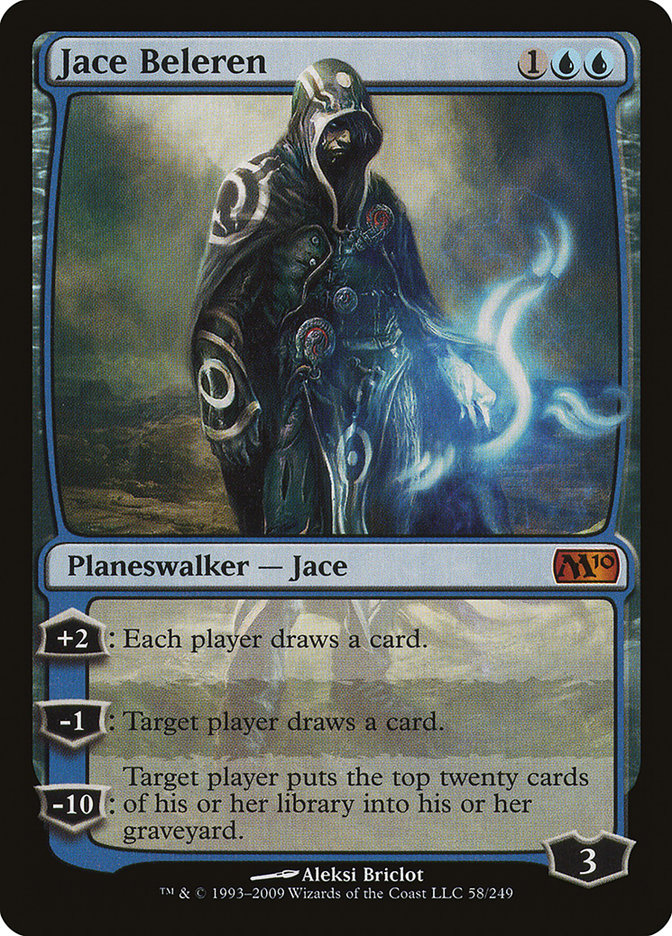
Points: 91
Copies: 21 maindeck, 9 sideboard
Championships: 2 (2008 World Champs, 2010 World Champs)
The original Jace makes his well-earned appearance here, featuring in many iterations of control decks over the years. A cheap mana cost combined with the three most powerful words in Magic (“draw a card”) have ensured that Jace Beleren has seen some play whenever this card is Standard-legal. This Jace also served a very important function during Jace, the Mind Sculptor‘s reign of terror – the old planeswalker uniqueness rules meant that only one of any given planeswalker subtype could be on the battlefield, and if any player resolved a second one, both would be destroyed. Jace Beleren‘s cheap mana cost meant he could be played before his more expensive brother, providing passive defense should an opponent think of casting the Mind Sculptor.
#7: Liliana of the Veil

Points: 126
Copies: 36 maindeck, 3 sideboard
Championships: 1 (2012 World Champs)
Make no mistake – Liliana of the Veil is one of the most powerful and defining planewalkers in Magic‘s entire history. Her unexpectedly low ranking here is not for lack of power or longevity. It’s simply due to the fact that most of her strongest work has been done in Modern, a format that has rarely been used for Pro Tours. While Liliana saw Standard play during her two years in the format, she didn’t have the support staff of powerful cards that she does in other formats. For evidence, look no further than Yuuya Watanabe’s 2012 Championship list: a textbook example of the Jund archetype in Modern, and a powerful reminder of Liliana‘s efficiency and effectiveness.
#6: Garruk Wildspeaker
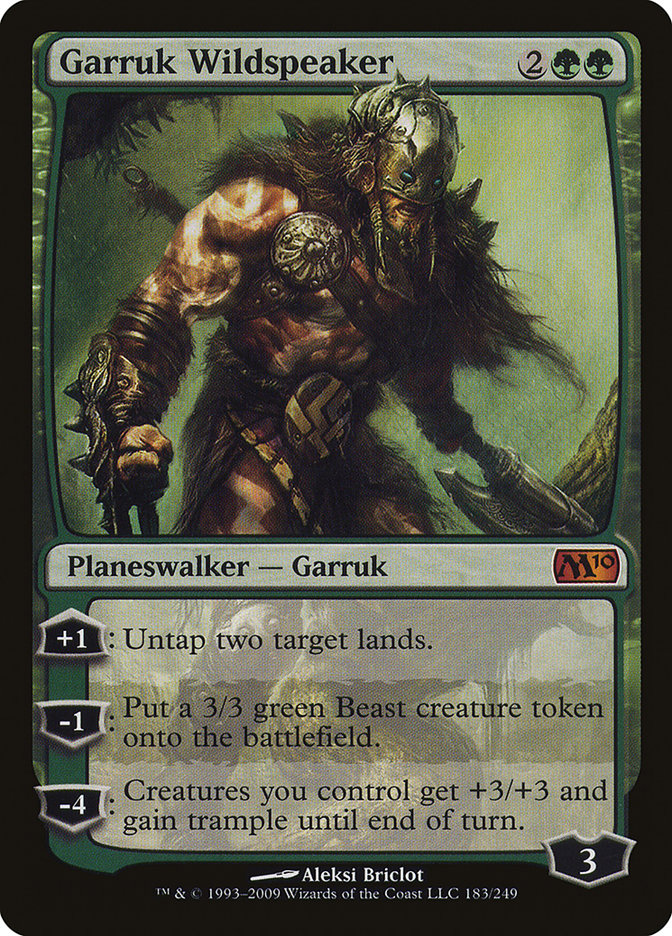
Points: 126
Copies: 33 maindeck, 3 sideboard
Championships: 3 (2007 World Champs, PT Hollywood 2008, PT San Diego 2010)
Now this one surprised me! The original Garruk found success immediately upon his release in Lorwyn, winning a championship in the hands of Uri Peleg and his Doran Midrange deck in 2007. Garruk would continue to put up showings in Top 8’s, however, whether they were in the dominant Green/Black Elves decks of the Lorwyn era, or in the Standard incarnations of Jund.
#5: Jace, Architect of Thought
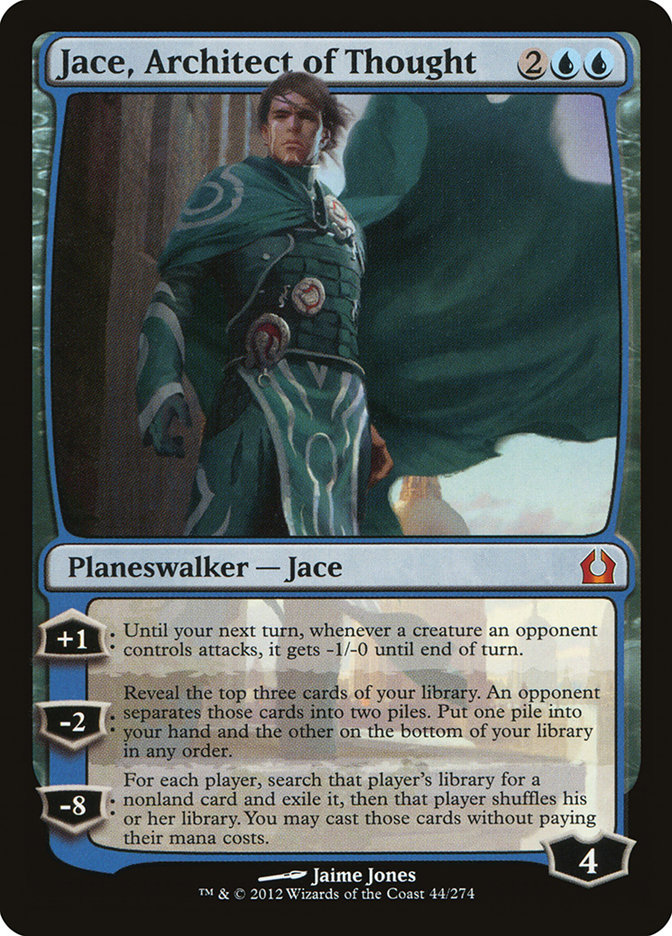
Points: 132
Copies: 31 maindeck, 9 sideboard
Championships: 3 (PT Theros, PT Magic 2015, PT Fate Reforged)
Who would have guessed that a Fact or Fiction effect stapled to an efficient, defensive planeswalker would be good? Well, pretty much everyone, as it would turn out. Jace, Architect of Thought sent ripples through Standard, often as part of the Blue/White Control deck that defined much of the Return to Ravnica block. As his original incarnation demonstrated, drawing cards is powerful, and Architect of Thought drew a lot of them. While Jace was an ideal mid-game play for control decks, he also found success in Mono-Blue Devotion, where his two blue mana symbols proved valuable.
#4: Jace, the Mind Sculptor
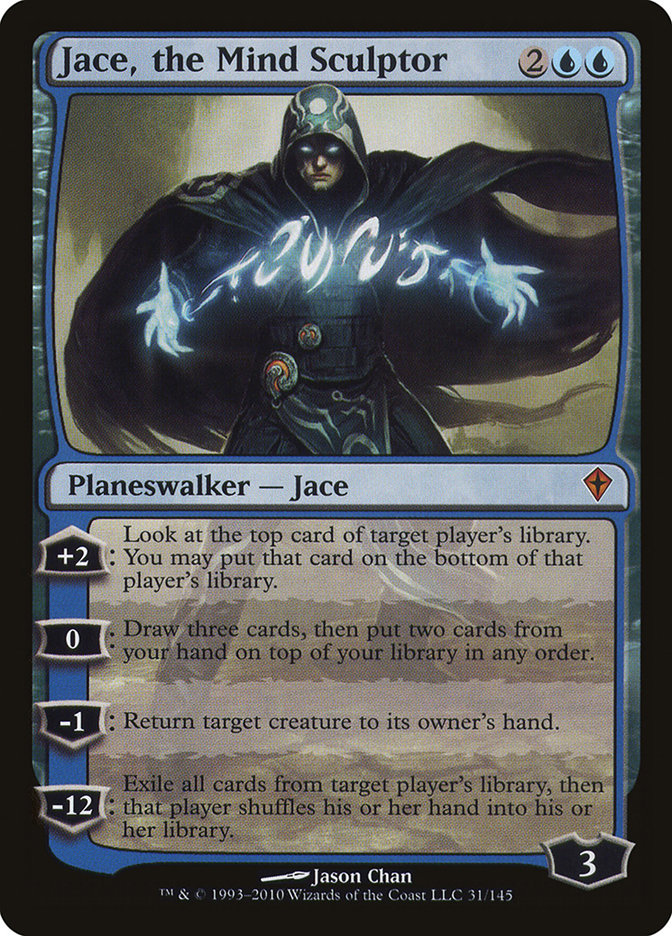
Points: 160
Copies: 44 maindeck, 2 sideboard
Championships: 2 (2010 World Champs, PT Paris 2011)
Anyone expecting the big blue meanie himself to take the top spot must be disappointed. But there’s just no way to talk about the Mind Sculptor without a lot of asterisks involved. Who knows what Jace‘s numbers would have looked like had he not been banned while he was in Standard. What we do know, however, is that this version of Jace was outright dominant while he was allowed to run loose in the wilds of competitive Magic. Jace, the Mind Sculptor proved too powerful for his era of Magic, since casting Brainstorm every turn provides unsurpassed card selection (especially when combined with fetchlands). If the words “Caw Blade” don’t instill a primal sense of fear in you, I encourage you to look up Ben Stark’s winning list from PT Paris 2011.
#3: Elspeth, Sun’s Champion

Points: 174
Copies: 42 maindeck, 8 sideboard
Championships: 4 (PT Journey into Nyx, PT Magic 2015, PT Khans of Tarkir, 2015 World Champs)
When I think about planeswalkers that end games, Elspeth, Sun’s Champion is the defining force that comes to mind. Throughout her tenure in the Standard format, Elspeth was your card of choice if you needed to put a game away. You thought Elspeth, Knight-Errant was annoying with one token per turn? Try three! Oh, and she can blow up all your biggest threats if you overextend. And if you can’t find a way to deal with her, she’ll create an emblem that pumps up those dinky little Soldier tokens. Elspeth was made to end games, and that she did, whether it was in Abzan Midrange decks or more traditional Blue/White Control.
#2: Chandra, Torch of Defiance

Points: 220
Copies: 40 maindeck, 35 sideboard
Championships: 5 (PT Aether Revolt, PT Hour of Devastation, 2017 World Champs, PT Dominaria, 2018 World Champs)
Of all the cards on this list, Chandra is the one I have personally played with the most, and I can say, without question, that she is a red player’s best friend. Her massive success on the Pro Tour stage comes from two solid years of dominance from Mono-Red strategies. Alongside Hazoret the Fervent, Chandra gave aggressive decks late-game sustainability and punch. Each of her four abilities was extremely relevant, providing flexibility, card selection, damage, removal, or a nearly unbeatable emblem. Perhaps the most notable number from her stats is the huge number of sideboard copies that pro players registered. While Chandra was rarely the Plan A for the red deck, she was the perfect card to prey on opponents who thought sweepers and life gain could halt you in your tracks.
#1: Gideon, Ally of Zendikar
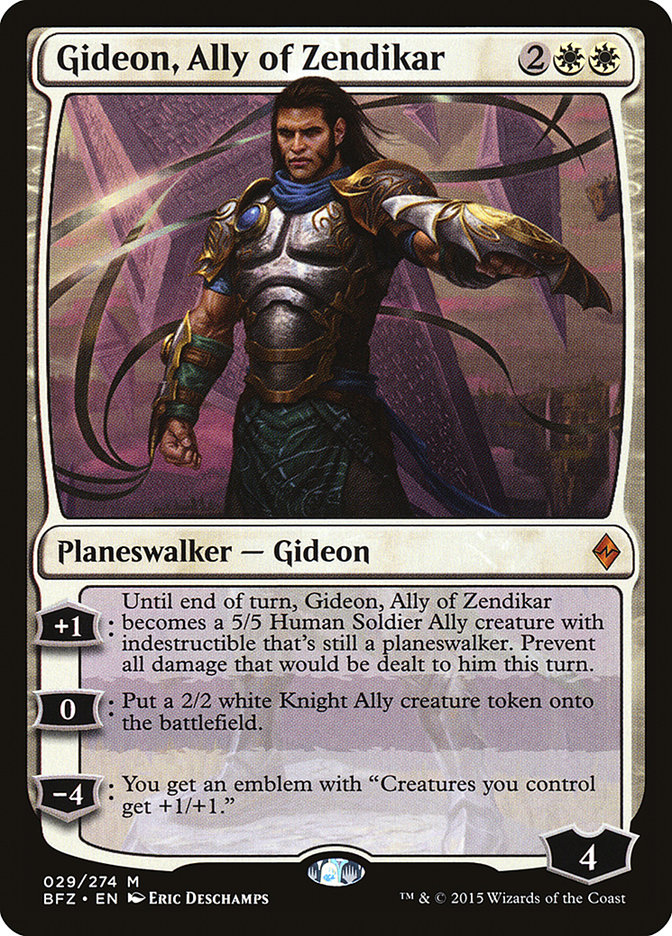
Points: 271
Copies: 52 maindeck, 31 sideboard
Championships: 5 (PT Battle for Zendikar, PT Shadows over Innistrad, PT Eldritch Moon, 2016 World Champs, PT Aether Revolt)
And here we have him – the most successful competitive planeswalker card ever. People may still debate whether Gideon deserved a ban or not during his time in the spotlight. Personally, I think Gideon stayed just barely on the right side of fair. (That said, I also lost many, many games to this monster.)
Gideon represented a radical change in how we assess planeswalkers. You didn’t tick his loyalty up gradually, building toward a game-breaking ultimate. He didn’t even remove threats from the battlefield! Yet, each of his three abilities could be used the moment he entered the battlefield, and all three were relevant.
Like Xenagos, the Reveler, he could provide an endless stream of tokens to defend or attack as needed. Like Elspeth, he could boost your entire board permanently. And should neither of those options work for you, he could simply transform into a 5/5 creature and smack your opponent upside the head. Without the need to build toward a powerful finishing ability, decks could freely run four copies of Gideon, replacing one card with another to double up on activations.
Perhaps most impressively, Gideon, Ally of Zendikar won five championships, each with a different archetype. He remains the planeswalker with the most professional success, and a standard by which future cards will be judged.
So, with War of the Spark about to throw 37 new planeswalkers into the mix (yes, I’m counting Tezzeret!), which cards do you think have a chance to crack the Planeswalker Hall of Fame? As you can see above, the competition is tough, but planeswalkers will remain a powerful and important part of the fabric of professional Magic.

Simon is a Retail Sales Specialist at Mox Boarding House Seattle. He started playing Magic during Odyssey block, finding success on the Junior Super Series circuit and eventually playing at the 2004 US Nationals. After a multi-year break from the game, he was brought back with the reprinting of his favorite card, Lightning Bolt, in the 2010 Core Set. Simon is a loyal Red Deck Wins player and is always doing his best to win with Mountains in every Constructed format. He has a deep affection for the Magic storyline and will happily discuss the peculiarities of the Kamigawa block with you upon request.

